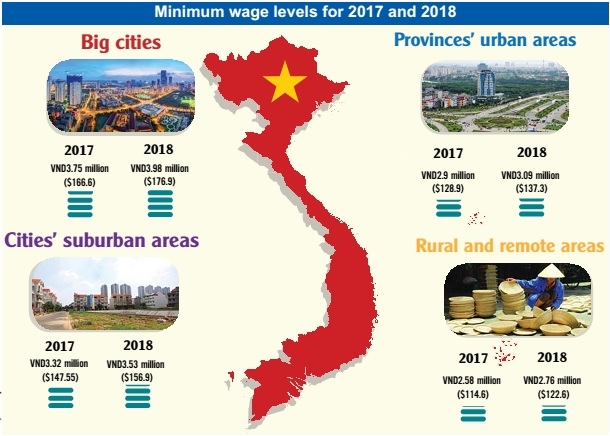Debate erupts over minimum wage increase
 |
| Debate erupts over minimum wage increase, Graph: Huy Pham |
The National Wage Council last week convened the Vietnam Chamber of Commerce and Industry (VCCI) representing employers, the Vietnam General Confederation of Labour (VGCL) representing employees, and a leader of the Ministry of Labour, Invalids, and Social Affairs (MoLISA) representing the government for the first round of negotiations on an increase in the regional minimum wage for private firm employees in 2019.
The VGCL proposed that the wage be raised by 7.5-8 per cent next year, meaning an additional VND220,000-330,000 ($9.77-14.66) per month on average, which could help employees meet about 95.4 per cent of their basic living standards.
This proposal was made based on the VGCL’s recent survey on the livelihoods of about 30,000 workers in 150 domestic and foreign firms in Vietnam, whose current wage levels can meet 90-92 per cent of their basic living standards.
“The 8-per-cent rise has been thoroughly calculated based on inflation, increased labour productivity, and demand for basic living standards,” Vu Quang Tho, head of the VGCL’s Institute for Workers and Trade Unions, said. “The economy has been growing strongly, with the number of newly-established enterprises now bigger than the number of enterprises going bankrupt. This is a positive signal for a rise in regional minimum wages.”
However, VCCI’s vice chairman Hoang Quang Phong argued that enterprises are now in difficulties and a rise in minimum wage will drive enterprises into larger problems.
“The majority of business associations are of the same view, saying that there should not be any climb in the minimum wage next year,” Phong said. “Labour productivity has yet to be improved, and such a climb would make a dent in enterprises’ budgets.”
According to the Korea Chamber of Business in Vietnam (Korcham), the proposed 7.5-8-per-cent increase is too high and will cause major worries for the more than 6,000 South Korean enterprises employing more than one million workers in Vietnam.
“Currently, not only South Korean enterprises, but all other foreign firms in Vietnam have to compete harshly, and such an increase will reduce their competitiveness,” a KorCham representative told VIR.
“Many South Korean firms are planning to build more factories in Vietnam. A rise in the minimum wage also means a rise in other allowance packages. Firms will have to pay more due to this,” he said.
South Korea is now Vietnam’s biggest foreign investor, with 6,988 projects registered at over $60 billion.
If the proposed rise by an additional VND220,000-330,000 ($9.77-14.66) in minimum wage is applied, the total additional wage that all South Korean firms would have to pay would be $9.77-14.66 million per month, exclusive of other expenses like insurances and allowances.
This year, the regional minimum wage increased by 6.5 per cent, equal to VND180,000-230,000 ($8-10.2) a month, which was the lowest increase ever.
Nguyen Thi Hanh, head of human resources at a South Korean garment firm in the southern province of Binh Duong, told VIR that her firm has had to raise wages by about 35 per cent since 2015, due to an average hike of 7 per cent a year in Vietnam’s minimum wage.
“We have had to pay another VND50 billion ($2.27 million) each year on average due to wage rises, which has also resulted in payments for allowances and insurance policies increasing,” Hanh said. “Meanwhile, our labour productivity has only increased by about 5-6 per cent, even though we have applied many training courses for workers.”
Deputy Minister of Labour, Invalids, and Social Affairs Doan Mau Diep, who is also chairman of the National Wage Council, said that next week, the VGCL, the VCCI, and the MoLISA will meet for the last round of negotiations in order to finalise the minimum wage increase for 2019. The new salary scheme will be submitted to the government for final approval.
What the stars mean:
★ Poor ★ ★ Promising ★★★ Good ★★★★ Very good ★★★★★ Exceptional
 Tag:
Tag:
Related Contents
Latest News
More News
- New initiative to boost the fight against domestic violence (November 26, 2025 | 10:00)
- South Korea funds IOM relief for Vietnam’s typhoon-affected communities (November 24, 2025 | 15:33)
- AI and human-centred values set to shape the future of HR in Vietnam (November 21, 2025 | 18:04)
- Kimberly-Clark and UNICEF strengthen child and maternal healthcare (November 17, 2025 | 18:08)
- Nestlé expands support for education and active lifestyles in Vietnam (November 17, 2025 | 17:52)
- Swing for the Kids Foundation supports school upgrades in Nghe An’s Do Luong district (November 16, 2025 | 10:00)
- Australia provides further $520,000 in typhoon aid to Vietnam (November 14, 2025 | 17:47)
- EU boosts emergency aid after Typhoon Kalmaegi (November 14, 2025 | 17:42)
- Pfizer Vietnam hosts symposia on pediatric pneumococcal disease (November 14, 2025 | 09:00)
- University of Medicine and Pharmacy develops vaccinology postgrad course (November 11, 2025 | 17:15)























 Mobile Version
Mobile Version